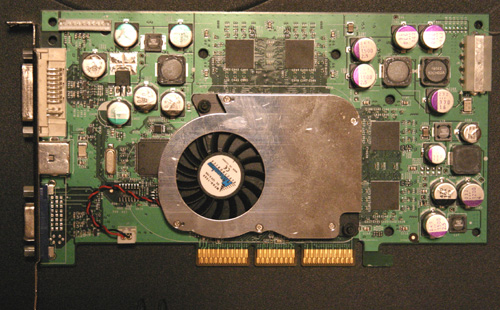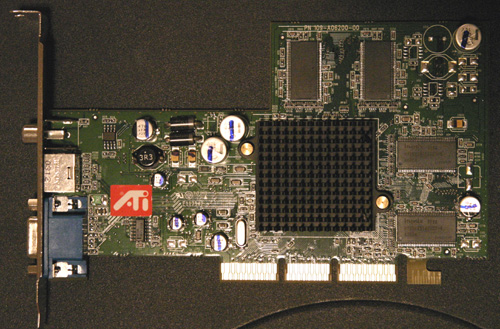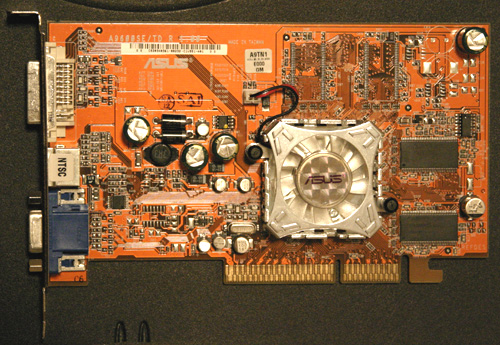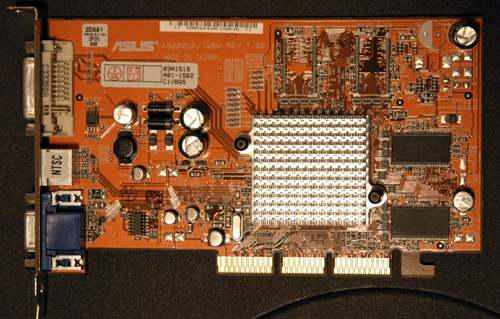
Original Link: https://www.anandtech.com/show/1207
Fall 2003 Video Card Roundup, Part 4: Budget Shootout
by Derek Wilson on December 15, 2003 11:14 AM EST- Posted in
- GPUs
Not everyone has the money to spend on graphics cards that cost two hundred dollars or more. And, not everyone who has money to spend cares to have the latest and greatest in features and performance. But whatever the reason, when building a PC on a budget, we want the most bang for our buck.
Current gaming performance is of utmost importance in this segment of the market as these cards aren't designed to be future-proof. Most DirectX 9 games will have a hard time running with their bells and whistles (the parts that will be written for DX9) turned on under these cards, especially at resolutions above 800x600. The best way to pick a budget card is to determine which game(s) are most important to you and buy the card that works best for that game regardless of other factors.
Many of the tests that we ran would have benefited from running resolutions lower than 1024x768, but we feel 10x7 is a valid resolution to shoot for these days. Lower resolutions are sometimes necessary, but this way, we can see what games for which these cards can handle with the extra load.
We will be pitting the budget cards against the cards from the earlier parts of this roundup series to add some performance reference. These numbers are just for perspective, as our current article employs the ATI CATALYST 3.9 drivers along with NVIDIA's 53.03 ForceWare release, while the previous performance numbers were run with CAT 3.8 and FW 52.16 drivers.
The Budget Cards
The NVIDIA GeForce FX 5200 Ultra has been around for a while, as has the ATI Radeon 9200. The newcomers in this review are the part of the SE line of Radeons from ATI: the 9600 SE and 9200 SE.
NVIDIA GeForce FX 5200 Ultra
We used a reference model of the GeForce FX 5200 Ultra. We note that this is the only card in the budget group to require power via a molex connector from the power supply.

This is an ATI designed Radeon 9200 card. This card is stated as being “DirectX 9.0 Compatible” as is its little brother, the 9200 SE. This is a step down from other current generation ATI cards, which claim that they are “DirectX 9.0 Compliant”. We will find out exactly what this means for games in our performance analysis.

ATI Radeon 9600 SE

ATI Radeon 9200 SE
The two SE models that we used are designed by ASUS . The difference between these cards and their counterparts is simple: the memory bus is cut from 128bits wide down to 64bits wide. This has a different impact on different games, lowering performance at the most on memory bandwidth intensive applications. Other than that difference, these cards are set up the same as existing non-pro 9600 cards and 9200 cards.
The test system that we used is the same as used in Part 2 and Part 3 of our roundup series:
AMD Athlon64 FX51
1GB DDR400 (2x512) RAM
nForce3 Motherboard
Without further ado, we bring you gaming performance.
Aquamark3 Performance
The 9600 SE had the best performance of the budget cards in this benchmark. The results in this are not surprising, since this game benchmark is based on DirectX 9 and the 9600 line of cards perform well in that area. More shade-intensive applications will be less sensitive to the cut in memory bandwidth on the 9600 SE as well (though the impact is still very evident). Even though Aquanox favors the 9600 based card, motion was very sluggish. If anyone wants to play Aquanox on a budget card, the resolution should be dropped lower than 10x7.
C&C Generals: Zero Hour Performance, No AA/AF
In this benchmark, the 9200 SE is the only card with real performance issues at 10x7. NVIDIA's offering is edged out by the 9200, but the 9600 SE is the clear performance leader in the budget segment.
C&C Generals: Zero Hour Performance, 4xAA/8xAF
Here, we see that the 5200 Ultra is more resilient when turning on aniso and antialiasing. The gap between the 9600 SE and the 5200 is much smaller, and the performance of the 9200 and 9200 SE fall off abruptly. The SE based cards take such a large performance hit because enabling AA significantly increases memory bandwidth requirements. We will be seeing similar performance hits for the 64bit memory bus SE cards in other games as well.
If C&C Generals: Zero Hour is your game, the 9600SE should be your budget card of choice.
EVE: The Second Genesis Performance, No AA/AF
The 5200 Ultra performs over 20% faster than the 9200 with the SE cards trailing. This indicates that EVE is a game that requires more memory bandwidth than the SE cards can handle.
EVE: The Second Genesis Performance, 4xAA/8xAF
All the cards here take a large performance hit, with the 9600SE gaining the lead.
F1 Challenge '99 - '02 Performance, No AA/AF
The NVIDIA 5200 Ultra is just faster than the ATI 9200 in this test. Unfortunately, NVIDIA still has to fix the jerky motion issue with this game, so we have to put the 9200 ahead of NVIDIA here.
F1 Challenge '99 - '02 Performance, 4xAA/8xAF
Once again, performance drops across the board with the 9600 SE taking the performance lead.
Final Fantasy XI Performance
The 9200 performed better than the 9600 SE in this test. The conclusion that we can draw from this is that FFXI is very sensitive to memory bandwidth. It makes sense that we would see such a large drop in performance when moving from the 9200 to 9200SE for the same reason. Here, the 5200 Ultra edges out the 9200 for the performance lead.
GunMetal Performance
Here, we have some interesting results that the graphs don't show. The 9200 and 9200 SE based cards failed to pass the validity test built in to the GunMetal Benchmark. The reason that the cards failed as reported by the benchmark was that some materials were unsupported. Since the only DX9 portion of GunMetal is VS2.0 based, it is possible that this game stresses a VS2.0 function with which the 9200 series is only “compatible” rather than “compliant”.
None of the cards run this benchmark very well, but the NVIDIA 5200 Ultra scores the highest marks here.
Halo Performance
The 9600 SE and 5200 Ultra perform just about equally on Halo. Both these cards are playable at this frame rate, but for those who require very solid frame rates, just drop the resolution down a notch.
Anyone wanting to play Halo with a 9200 based card would want to do so with fewer lower quality options and on a lower resolution than 10x7.
Homeworld 2 Performance, No AA/AF
For this benchmark, the 9200 based cards gave us some unexplainable results, and we are following up with ATI on these issues. In both these tests, the ATI 9600 SE card performed best.
Jedi Knight: Jedi Academy Performance, No AA/AF
As with the Homeworld 2 benchmarks, the 9200 cards gave us strange results for this Quake 3 engine-based game.
Jedi Knight: Jedi Academy Performance, 4xAA/8xAF
The NVIDIA GeForce FX5200 Ultra has a slight edge over the ATI cards in this test. The quality of the glow effects on NVIDIA cards is also of higher quality than that seen on ATI cards.
Neverwinter Nights: Shadow of Undrendtide Performance, No AA/AF
The 9600SE and 9200 both beat out the NVIDIA 5200 Ultra in this benchmark. This is interesting, considering that Neverwinter Nights was written in OpenGL around NVIDIA hardware and has done better traditionally on the same. The positive thing to note about NVIDIA performance on this benchmark is that the minimum frame rate was 12 as opposed to the 9 for both ATI cards.
Neverwinter Nights: Shadow of Undrendtide Performance, 4xAA/8xAF
Again, the 9600 SE card beats out NVIDIA on this benchmark, but the 9200 based cards take a severe performance hit.
SimCity 4 Performance, No AA/AF
NVIDIA outperforms the ATI cards by a good margin on this benchmark, almost equaling the performance of the other NVIDIA cards in this benchmark.
SimCity 4 Performance, 4xAA/8xAF
Here, the tables turn and we see almost no performance hit for enabling AA and AF on ATI cards in this benchmark, while the performance of the NVIDIA card drops considerably. The usefulness of turning on AA and AF for this game is of questionable use. We are still trying to refine our benchmark in general for this game.
Splinter Cell Performance
In this benchmark, the GeForce FX 5200 Ultra is the performance leader. The fact that the 9600 SE trails in this benchmark indicates that Splinter Cell is another game sensitive to memory bandwidth.
Tron 2.0 Performance, No AA/AF
NVIDIA leads this benchmark by a few frames per second.
Tron 2.0 Performance, 4xAA/8xAF
When aniso and antialiasing are enabled, the 9600 SE takes the performance lead. Anisotropic filtering might not be of very much use in this game as textures are mostly solid colors. Antialiasing does add to the gaming experience though.
Unreal Tournament 2003 Performance, No AA/AF
The 5200 Ultra performs better than the other budget cards in Unreal Tournament 2003.
Unreal Tournament 2003 Performance, 4xAA/8xAF
The NVIDIA offering maintains its lead with antialiasing and anisotropic filtering enabled.
Warcraft III: Frozen Throne Performance, No AA/AF
Here, the Radeon 9200 leads in performance.
Warcraft III: Frozen Throne Performance, 4xAA/8xAF
The 9600 SE takes the least performance hit when AA and AF are enabled and so, gains the lead in this benchmark followed by the 5200 Ultra.
Wolfenstein: Enemy Territory Performance, No AA/AF
This Quake 3 engine-based game performs best on the Radeon 9200 card. The 5200 Ultra is the lowest performing card of the bunch in this test.
Wolfenstein: Enemy Territory Performance, 4xAA/AF
By enabling our standard set of options, the 9200 SE takes a huge performance hit dropping to the back of the group. The 9600 SE takes the performance lead and the 5200 Ultra performs on par with the 9200.
X2: The Threat Performance, No AA/AF
The 5200 Ultra has the highest frame rates in this benchmark, and although the 53.03 smooths out the performance a little bit, there is still a little stop-and-go in the motion of this game.
X2: The Threat Performance, 4xAA/8xAF
For X2 with all the options, the 9600 SE takes the lead, while the 9200 SE brings up the rear with nearly 3 frames per second.
Final Words
One thing that we can say for sure about the performance in this review is that the 9200 SE is consistently low and has frame rates lower than 10 in quite a few games. The advantage of the card is that it is the cheapest of the bunch and can be found for about half the price of the 9600 SE or 5200 Ultra cards (which is impressive for this price range). The 9200 SE does have decent performance in some games, and most games are decently playable at resolutions under 10x7.If absolute minimum price is your requirement (and you happen to like one of the games in which it performed well), the ATI Radeon 9200 SE is the card for you.
The 9200 is slightly less expensive than the 9600 SE. The games that the 9200 SE did well in were topped by the 9200 in every case, but at this price point, it may be better to go with the 9600 SE, as it has consistently high performance, more than either of the cheaper cards. The same can be said about the NVIDIA 5200 Ultra.
If performance at a low price is what you are after, either the 9600 SE or the 5200 Ultra is a good choice. The best way to decide is definitely to look at the games that you will be playing. We recommend against buying the ATI Radeon 9200 non-pro, as you can get better performance for only slightly more money.
It is important to bear in mind that, even though two of these cards have full DX9 support, next generation games won't run very fast on them. The budget segment, however, is a beautiful thing if you need a stop gap card while waiting for the next generation of GPUs to come out in the spring.







